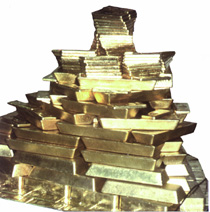Money
Matters: An IMF Exhibit -- The Importance of Global Cooperation
|
Reinventing
the System (1972-1981)
|
Part
1 of 7
|
|
|
|
| |
Would
Floating Rates Sink the System?
|
|
The System in Crisis |
Next--> |
| |
|
In
spite of the surprising U.S. decision in 1971 to take the dollar
off the gold standard, the world still clung to the old system.
In attempts to set more realistic exchange rates, the U.S. dollar
was devalued and stronger currencies, like the German mark and the
Japanese yen, were revalued. But even after two devaluations, the
flight from the U.S. dollar continued. No new set of exchange rates
could be sustained. Finally, in early 1973, fixed exchange rates
based on gold were abandoned altogether and currencies were left
to float. Although governments continued to intervene, market forces
now determined exchange rates.
Could an international monetary system based on floating rates actually
work?
|
Monetary
Revolution
|
|
For
thousands of years, "money" had been based on a tangible,
valuable commodity such as gold or silver. In the early 1970s, the
international community abandoned the security and discipline of
a fixed-rate metal standard. In its place, the world adopted a system
of "floating" exchange rates: each currency’s value
moved up or down depending on international demand and the amount
of confidence in its country’s economy.
|

Gold Bullion
credits
|
Floating
Rate Systems
|
Free
Floating Exchange Rate
|
|
The
currency's value is determined solely by supply and demand in the
market, rather than official policy. Countries generally permit
a free float only as a temporary solution, because it could result
in excessive fluctuations. Such fluctuations disrupt international
transactions by constantly altering the cost of goods and value
of payments between companies in different countries.
|

credits |
Managed
Floating Exchange Rate
|
|
This type is similar to a free floating exchange rate, but
a government intervenes by buying or selling its own currency
to minimize fluctuations. Australia, Canada, Jamaica, Japan,
the Philippines, the United States, and others adopted this
type of exchange rate.
|
Currency
Peg
|
|
The currency's value is pegged to a basket of currencies or
to another country's currency. Many developing countries pegged
their exchange rates to the SDR or to the currency of an industrial
country with which they traded heavily.
|
The
European Snake
|
|
Beginning
in mid-1972, the EEC stabilized its own currencies in relation
to one another. This system was dubbed the "European
Snake." Each country agreed not to allow its currency
to fluctuate more than 1 1/8% up or down from an agreed central
exchange rate. The EEC currencies floated jointly against
the dollar. The Snake was the forerunner of the European Monetary
System, which went into effect in 1979.
|
|
With
the collapse of the Bretton Woods system, had the IMF outlived its
usefulness?
|
|
Critics
argued that the world no longer needed an organization designed
to monitor a system that was now obsolete.
But
the IMF adapted to the new circumstances and actually began to take
an even more influential role in the world’s monetary system.
- Instead
of monitoring fixed exchange rates, the IMF took on the responsibility
of exercising firm surveillance
over its members' exchange-rate policies.
- To
help countries with balance of payments deficits, the IMF increased
its lending activities.
|
| |
|
|
|
The System in Crisis |
Next--> |